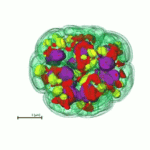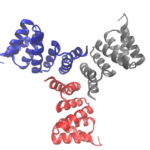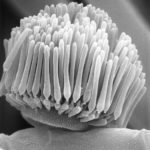Scientists have sequenced the genome of a green alga that has drawn commercial interest as a strong producer of quality lipids for biofuel production. The chromosome-assembly genome of Chromochloris zofingiensis provides a blueprint for new discoveries in sustainable biofuels, antioxidants, and other valuable bioproducts. The team was led by Kris Niyogi, faculty biologist in the Molecular Biophysics and Integrated Bioimaging Division and included researchers from UCLA and UCSF. The alga was imaged in the National Center for X-ray Tomography, located at the Advanced Light Source. Read the science short at the Berkeley Lab News Center.
Berkeley Public Schools Fund Honors EGSB’s Mary Wildermuth
 Mary Wildermuth, Faculty Scientist with the Environmental Genomics and Systems Biology Division will honored on May 12, 2017 at the Berkeley Public Schools Fund Spring Luncheon for her contributions to Berkeley schools. With a grant from the Berkeley Public Schools Fund, Wildermuth volunteered her time to develop Be a Scientist, a 7th grade science program that brings 200 science mentors from UC Berkeley to lead individual students at Berkeley’s three middle schools through a process of scientific inquiry and investigation. Berkeleyside recently featured an article about this program.
Mary Wildermuth, Faculty Scientist with the Environmental Genomics and Systems Biology Division will honored on May 12, 2017 at the Berkeley Public Schools Fund Spring Luncheon for her contributions to Berkeley schools. With a grant from the Berkeley Public Schools Fund, Wildermuth volunteered her time to develop Be a Scientist, a 7th grade science program that brings 200 science mentors from UC Berkeley to lead individual students at Berkeley’s three middle schools through a process of scientific inquiry and investigation. Berkeleyside recently featured an article about this program.
Designing Cyclic Oligomers: Greater than the Sum of Their Parts
Cyclic proteins that assemble from multiple identical subunits (homo-oligomers) play key roles in many biological processes, including enzymatic catalysis and function and cell signaling. Researchers in the Molecular Biophysics and Integrated Bioimaging (MBIB) Division worked with University of Washington’s David Baker, who led a team to design in silico and crystallize self-assembling cyclic homo-oligomer proteins.
DOE JGI Finds A New Major Gene Expression Regulator in Fungi
Just four letters – A, C, T, and G – make up an organism’s genetic code. Changing a single letter, or base, can lead to changes in protein structures and functions, impacting an organism’s traits. In addition, though, subtler changes can and do happen, involving modifications of the DNA bases themselves. In the May 8, 2017 issue of Nature Genetics, a team led by scientists at the U.S. Department of Energy Joint Genome Institute (JGI), a DOE Office of Science User Facility, report the prevalence of modifications in the earliest branches of the fungal kingdom. Read more in the JGI press release.
Faculty Scientist Mary Firestone Elected to National Academy of Sciences
Mary Firestone, a faculty scientist with a secondary affiliation in the Environmental Genomics and Systems Biology Division and professor of soil microbiology at UC Berkeley’s Department of Environmental Science, Policy and Management, has been elected to The National Academy of Sciences. Election to the National Academy honors scientists who make distinguished and continuing achievements in their fields. Firestone’s research involves the fundamental understanding of soil microbial ecology, and its applications to problems such as global change, sustainability, and biodegradation. Learn more about the newly elected members in the NAS press release.
- « Previous Page
- 1
- …
- 153
- 154
- 155
- 156
- 157
- …
- 213
- Next Page »
Was this page useful?








